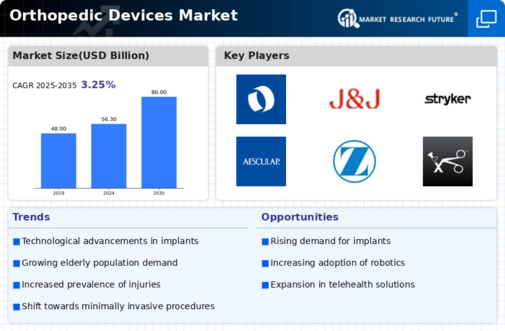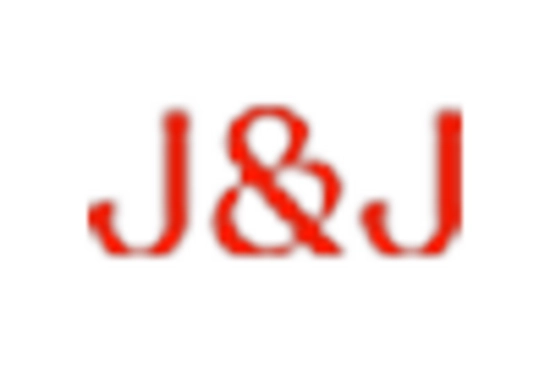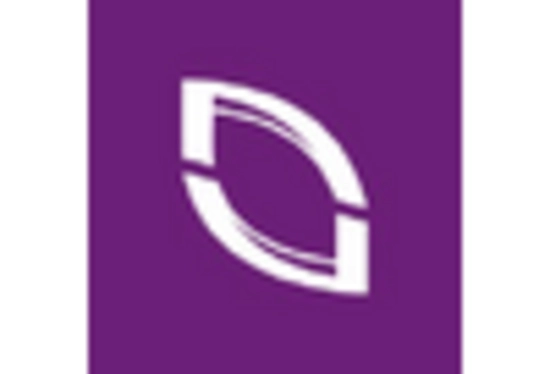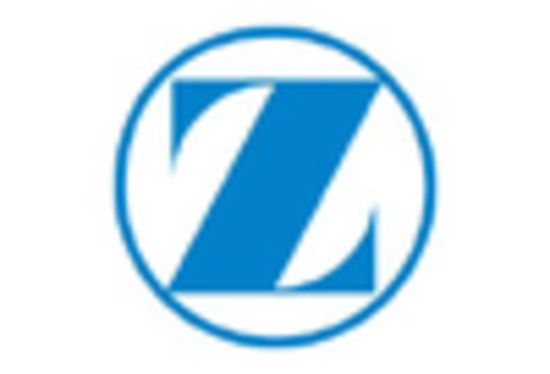Joint Reconstruction Devices
Spinal Devices
Cranial Orthoses
Orthobiologics
Support Devices
Metal
Plastic
Ceramics
Composite
Biodegradable Materials
Hospitals
Orthopedic Clinics
Rehabilitation Centers
Ambulatory Surgical Centers
Osteoarthritis
Trauma
Spinal Disorders
Fractures
Sports Injuries
North America
Europe
South America
Asia Pacific
Middle East and Africa
North America Outlook (USD Billion, 2019-2035)
North America Orthopedic Devices Market by Product Type
Joint Reconstruction Devices
Spinal Devices
Cranial Orthoses
Orthobiologics
Support Devices
North America Orthopedic Devices Market by Material Type
Metal
Plastic
Ceramics
Composite
Biodegradable Materials
North America Orthopedic Devices Market by End User Type
Hospitals
Orthopedic Clinics
Rehabilitation Centers
Ambulatory Surgical Centers
North America Orthopedic Devices Market by Indication Type
Osteoarthritis
Trauma
Spinal Disorders
Fractures
Sports Injuries
North America Orthopedic Devices Market by Regional Type
US
Canada
US Outlook (USD Billion, 2019-2035)
US Orthopedic Devices Market by Product Type
Joint Reconstruction Devices
Spinal Devices
Cranial Orthoses
Orthobiologics
Support Devices
US Orthopedic Devices Market by Material Type
Metal
Plastic
Ceramics
Composite
Biodegradable Materials
US Orthopedic Devices Market by End User Type
Hospitals
Orthopedic Clinics
Rehabilitation Centers
Ambulatory Surgical Centers
US Orthopedic Devices Market by Indication Type
Osteoarthritis
Trauma
Spinal Disorders
Fractures
Sports Injuries
CANADA Outlook (USD Billion, 2019-2035)
CANADA Orthopedic Devices Market by Product Type
Joint Reconstruction Devices
Spinal Devices
Cranial Orthoses
Orthobiologics
Support Devices
CANADA Orthopedic Devices Market by Material Type
Metal
Plastic
Ceramics
Composite
Biodegradable Materials
CANADA Orthopedic Devices Market by End User Type
Hospitals
Orthopedic Clinics
Rehabilitation Centers
Ambulatory Surgical Centers
CANADA Orthopedic Devices Market by Indication Type
Osteoarthritis
Trauma
Spinal Disorders
Fractures
Sports Injuries
Europe Outlook (USD Billion, 2019-2035)
Europe Orthopedic Devices Market by Product Type
Joint Reconstruction Devices
Spinal Devices
Cranial Orthoses
Orthobiologics
Support Devices
Europe Orthopedic Devices Market by Material Type
Metal
Plastic
Ceramics
Composite
Biodegradable Materials
Europe Orthopedic Devices Market by End User Type
Hospitals
Orthopedic Clinics
Rehabilitation Centers
Ambulatory Surgical Centers
Europe Orthopedic Devices Market by Indication Type
Osteoarthritis
Trauma
Spinal Disorders
Fractures
Sports Injuries
Europe Orthopedic Devices Market by Regional Type
Germany
UK
France
Russia
Italy
Spain
Rest of Europe
GERMANY Outlook (USD Billion, 2019-2035)
GERMANY Orthopedic Devices Market by Product Type
Joint Reconstruction Devices
Spinal Devices
Cranial Orthoses
Orthobiologics
Support Devices
GERMANY Orthopedic Devices Market by Material Type
Metal
Plastic
Ceramics
Composite
Biodegradable Materials
GERMANY Orthopedic Devices Market by End User Type
Hospitals
Orthopedic Clinics
Rehabilitation Centers
Ambulatory Surgical Centers
GERMANY Orthopedic Devices Market by Indication Type
Osteoarthritis
Trauma
Spinal Disorders
Fractures
Sports Injuries
UK Outlook (USD Billion, 2019-2035)
UK Orthopedic Devices Market by Product Type
Joint Reconstruction Devices
Spinal Devices
Cranial Orthoses
Orthobiologics
Support Devices
UK Orthopedic Devices Market by Material Type
Metal
Plastic
Ceramics
Composite
Biodegradable Materials
UK Orthopedic Devices Market by End User Type
Hospitals
Orthopedic Clinics
Rehabilitation Centers
Ambulatory Surgical Centers
UK Orthopedic Devices Market by Indication Type
Osteoarthritis
Trauma
Spinal Disorders
Fractures
Sports Injuries
FRANCE Outlook (USD Billion, 2019-2035)
FRANCE Orthopedic Devices Market by Product Type
Joint Reconstruction Devices
Spinal Devices
Cranial Orthoses
Orthobiologics
Support Devices
FRANCE Orthopedic Devices Market by Material Type
Metal
Plastic
Ceramics
Composite
Biodegradable Materials
FRANCE Orthopedic Devices Market by End User Type
Hospitals
Orthopedic Clinics
Rehabilitation Centers
Ambulatory Surgical Centers
FRANCE Orthopedic Devices Market by Indication Type
Osteoarthritis
Trauma
Spinal Disorders
Fractures
Sports Injuries
RUSSIA Outlook (USD Billion, 2019-2035)
RUSSIA Orthopedic Devices Market by Product Type
Joint Reconstruction Devices
Spinal Devices
Cranial Orthoses
Orthobiologics
Support Devices
RUSSIA Orthopedic Devices Market by Material Type
Metal
Plastic
Ceramics
Composite
Biodegradable Materials
RUSSIA Orthopedic Devices Market by End User Type
Hospitals
Orthopedic Clinics
Rehabilitation Centers
Ambulatory Surgical Centers
RUSSIA Orthopedic Devices Market by Indication Type
Osteoarthritis
Trauma
Spinal Disorders
Fractures
Sports Injuries
ITALY Outlook (USD Billion, 2019-2035)
ITALY Orthopedic Devices Market by Product Type
Joint Reconstruction Devices
Spinal Devices
Cranial Orthoses
Orthobiologics
Support Devices
ITALY Orthopedic Devices Market by Material Type
Metal
Plastic
Ceramics
Composite
Biodegradable Materials
ITALY Orthopedic Devices Market by End User Type
Hospitals
Orthopedic Clinics
Rehabilitation Centers
Ambulatory Surgical Centers
ITALY Orthopedic Devices Market by Indication Type
Osteoarthritis
Trauma
Spinal Disorders
Fractures
Sports Injuries
SPAIN Outlook (USD Billion, 2019-2035)
SPAIN Orthopedic Devices Market by Product Type
Joint Reconstruction Devices
Spinal Devices
Cranial Orthoses
Orthobiologics
Support Devices
SPAIN Orthopedic Devices Market by Material Type
Metal
Plastic
Ceramics
Composite
Biodegradable Materials
SPAIN Orthopedic Devices Market by End User Type
Hospitals
Orthopedic Clinics
Rehabilitation Centers
Ambulatory Surgical Centers
SPAIN Orthopedic Devices Market by Indication Type
Osteoarthritis
Trauma
Spinal Disorders
Fractures
Sports Injuries
REST OF EUROPE Outlook (USD Billion, 2019-2035)
REST OF EUROPE Orthopedic Devices Market by Product Type
Joint Reconstruction Devices
Spinal Devices
Cranial Orthoses
Orthobiologics
Support Devices
REST OF EUROPE Orthopedic Devices Market by Material Type
Metal
Plastic
Ceramics
Composite
Biodegradable Materials
REST OF EUROPE Orthopedic Devices Market by End User Type
Hospitals
Orthopedic Clinics
Rehabilitation Centers
Ambulatory Surgical Centers
REST OF EUROPE Orthopedic Devices Market by Indication Type
Osteoarthritis
Trauma
Spinal Disorders
Fractures
Sports Injuries
APAC Outlook (USD Billion, 2019-2035)
APAC Orthopedic Devices Market by Product Type
Joint Reconstruction Devices
Spinal Devices
Cranial Orthoses
Orthobiologics
Support Devices
APAC Orthopedic Devices Market by Material Type
Metal
Plastic
Ceramics
Composite
Biodegradable Materials
APAC Orthopedic Devices Market by End User Type
Hospitals
Orthopedic Clinics
Rehabilitation Centers
Ambulatory Surgical Centers
APAC Orthopedic Devices Market by Indication Type
Osteoarthritis
Trauma
Spinal Disorders
Fractures
Sports Injuries
APAC Orthopedic Devices Market by Regional Type
China
India
Japan
South Korea
Malaysia
Thailand
Indonesia
Rest of APAC
CHINA Outlook (USD Billion, 2019-2035)
CHINA Orthopedic Devices Market by Product Type
Joint Reconstruction Devices
Spinal Devices
Cranial Orthoses
Orthobiologics
Support Devices
CHINA Orthopedic Devices Market by Material Type
Metal
Plastic
Ceramics
Composite
Biodegradable Materials
CHINA Orthopedic Devices Market by End User Type
Hospitals
Orthopedic Clinics
Rehabilitation Centers
Ambulatory Surgical Centers
CHINA Orthopedic Devices Market by Indication Type
Osteoarthritis
Trauma
Spinal Disorders
Fractures
Sports Injuries
INDIA Outlook (USD Billion, 2019-2035)
INDIA Orthopedic Devices Market by Product Type
Joint Reconstruction Devices
Spinal Devices
Cranial Orthoses
Orthobiologics
Support Devices
INDIA Orthopedic Devices Market by Material Type
Metal
Plastic
Ceramics
Composite
Biodegradable Materials
INDIA Orthopedic Devices Market by End User Type
Hospitals
Orthopedic Clinics
Rehabilitation Centers
Ambulatory Surgical Centers
INDIA Orthopedic Devices Market by Indication Type
Osteoarthritis
Trauma
Spinal Disorders
Fractures
Sports Injuries
JAPAN Outlook (USD Billion, 2019-2035)
JAPAN Orthopedic Devices Market by Product Type
Joint Reconstruction Devices
Spinal Devices
Cranial Orthoses
Orthobiologics
Support Devices
JAPAN Orthopedic Devices Market by Material Type
Metal
Plastic
Ceramics
Composite
Biodegradable Materials
JAPAN Orthopedic Devices Market by End User Type
Hospitals
Orthopedic Clinics
Rehabilitation Centers
Ambulatory Surgical Centers
JAPAN Orthopedic Devices Market by Indication Type
Osteoarthritis
Trauma
Spinal Disorders
Fractures
Sports Injuries
SOUTH KOREA Outlook (USD Billion, 2019-2035)
SOUTH KOREA Orthopedic Devices Market by Product Type
Joint Reconstruction Devices
Spinal Devices
Cranial Orthoses
Orthobiologics
Support Devices
SOUTH KOREA Orthopedic Devices Market by Material Type
Metal
Plastic
Ceramics
Composite
Biodegradable Materials
SOUTH KOREA Orthopedic Devices Market by End User Type
Hospitals
Orthopedic Clinics
Rehabilitation Centers
Ambulatory Surgical Centers
SOUTH KOREA Orthopedic Devices Market by Indication Type
Osteoarthritis
Trauma
Spinal Disorders
Fractures
Sports Injuries
MALAYSIA Outlook (USD Billion, 2019-2035)
MALAYSIA Orthopedic Devices Market by Product Type
Joint Reconstruction Devices
Spinal Devices
Cranial Orthoses
Orthobiologics
Support Devices
MALAYSIA Orthopedic Devices Market by Material Type
Metal
Plastic
Ceramics
Composite
Biodegradable Materials
MALAYSIA Orthopedic Devices Market by End User Type
Hospitals
Orthopedic Clinics
Rehabilitation Centers
Ambulatory Surgical Centers
MALAYSIA Orthopedic Devices Market by Indication Type
Osteoarthritis
Trauma
Spinal Disorders
Fractures
Sports Injuries
THAILAND Outlook (USD Billion, 2019-2035)
THAILAND Orthopedic Devices Market by Product Type
Joint Reconstruction Devices
Spinal Devices
Cranial Orthoses
Orthobiologics
Support Devices
THAILAND Orthopedic Devices Market by Material Type
Metal
Plastic
Ceramics
Composite
Biodegradable Materials
THAILAND Orthopedic Devices Market by End User Type
Hospitals
Orthopedic Clinics
Rehabilitation Centers
Ambulatory Surgical Centers
THAILAND Orthopedic Devices Market by Indication Type
Osteoarthritis
Trauma
Spinal Disorders
Fractures
Sports Injuries
INDONESIA Outlook (USD Billion, 2019-2035)
INDONESIA Orthopedic Devices Market by Product Type
Joint Reconstruction Devices
Spinal Devices
Cranial Orthoses
Orthobiologics
Support Devices
INDONESIA Orthopedic Devices Market by Material Type
Metal
Plastic
Ceramics
Composite
Biodegradable Materials
INDONESIA Orthopedic Devices Market by End User Type
Hospitals
Orthopedic Clinics
Rehabilitation Centers
Ambulatory Surgical Centers
INDONESIA Orthopedic Devices Market by Indication Type
Osteoarthritis
Trauma
Spinal Disorders
Fractures
Sports Injuries
REST OF APAC Outlook (USD Billion, 2019-2035)
REST OF APAC Orthopedic Devices Market by Product Type
Joint Reconstruction Devices
Spinal Devices
Cranial Orthoses
Orthobiologics
Support Devices
REST OF APAC Orthopedic Devices Market by Material Type
Metal
Plastic
Ceramics
Composite
Biodegradable Materials
REST OF APAC Orthopedic Devices Market by End User Type
Hospitals
Orthopedic Clinics
Rehabilitation Centers
Ambulatory Surgical Centers
REST OF APAC Orthopedic Devices Market by Indication Type
Osteoarthritis
Trauma
Spinal Disorders
Fractures
Sports Injuries
South America Outlook (USD Billion, 2019-2035)
South America Orthopedic Devices Market by Product Type
Joint Reconstruction Devices
Spinal Devices
Cranial Orthoses
Orthobiologics
Support Devices
South America Orthopedic Devices Market by Material Type
Metal
Plastic
Ceramics
Composite
Biodegradable Materials
South America Orthopedic Devices Market by End User Type
Hospitals
Orthopedic Clinics
Rehabilitation Centers
Ambulatory Surgical Centers
South America Orthopedic Devices Market by Indication Type
Osteoarthritis
Trauma
Spinal Disorders
Fractures
Sports Injuries
South America Orthopedic Devices Market by Regional Type
Brazil
Mexico
Argentina
Rest of South America
BRAZIL Outlook (USD Billion, 2019-2035)
BRAZIL Orthopedic Devices Market by Product Type
Joint Reconstruction Devices
Spinal Devices
Cranial Orthoses
Orthobiologics
Support Devices
BRAZIL Orthopedic Devices Market by Material Type
Metal
Plastic
Ceramics
Composite
Biodegradable Materials
BRAZIL Orthopedic Devices Market by End User Type
Hospitals
Orthopedic Clinics
Rehabilitation Centers
Ambulatory Surgical Centers
BRAZIL Orthopedic Devices Market by Indication Type
Osteoarthritis
Trauma
Spinal Disorders
Fractures
Sports Injuries
MEXICO Outlook (USD Billion, 2019-2035)
MEXICO Orthopedic Devices Market by Product Type
Joint Reconstruction Devices
Spinal Devices
Cranial Orthoses
Orthobiologics
Support Devices
MEXICO Orthopedic Devices Market by Material Type
Metal
Plastic
Ceramics
Composite
Biodegradable Materials
MEXICO Orthopedic Devices Market by End User Type
Hospitals
Orthopedic Clinics
Rehabilitation Centers
Ambulatory Surgical Centers
MEXICO Orthopedic Devices Market by Indication Type
Osteoarthritis
Trauma
Spinal Disorders
Fractures
Sports Injuries
ARGENTINA Outlook (USD Billion, 2019-2035)
ARGENTINA Orthopedic Devices Market by Product Type
Joint Reconstruction Devices
Spinal Devices
Cranial Orthoses
Orthobiologics
Support Devices
ARGENTINA Orthopedic Devices Market by Material Type
Metal
Plastic
Ceramics
Composite
Biodegradable Materials
ARGENTINA Orthopedic Devices Market by End User Type
Hospitals
Orthopedic Clinics
Rehabilitation Centers
Ambulatory Surgical Centers
ARGENTINA Orthopedic Devices Market by Indication Type
Osteoarthritis
Trauma
Spinal Disorders
Fractures
Sports Injuries
REST OF SOUTH AMERICA Outlook (USD Billion, 2019-2035)
REST OF SOUTH AMERICA Orthopedic Devices Market by Product Type
Joint Reconstruction Devices
Spinal Devices
Cranial Orthoses
Orthobiologics
Support Devices
REST OF SOUTH AMERICA Orthopedic Devices Market by Material Type
Metal
Plastic
Ceramics
Composite
Biodegradable Materials
REST OF SOUTH AMERICA Orthopedic Devices Market by End User Type
Hospitals
Orthopedic Clinics
Rehabilitation Centers
Ambulatory Surgical Centers
REST OF SOUTH AMERICA Orthopedic Devices Market by Indication Type
Osteoarthritis
Trauma
Spinal Disorders
Fractures
Sports Injuries
MEA Outlook (USD Billion, 2019-2035)
MEA Orthopedic Devices Market by Product Type
Joint Reconstruction Devices
Spinal Devices
Cranial Orthoses
Orthobiologics
Support Devices
MEA Orthopedic Devices Market by Material Type
Metal
Plastic
Ceramics
Composite
Biodegradable Materials
MEA Orthopedic Devices Market by End User Type
Hospitals
Orthopedic Clinics
Rehabilitation Centers
Ambulatory Surgical Centers
MEA Orthopedic Devices Market by Indication Type
Osteoarthritis
Trauma
Spinal Disorders
Fractures
Sports Injuries
MEA Orthopedic Devices Market by Regional Type
GCC Countries
South Africa
Rest of MEA
GCC COUNTRIES Outlook (USD Billion, 2019-2035)
GCC COUNTRIES Orthopedic Devices Market by Product Type
Joint Reconstruction Devices
Spinal Devices
Cranial Orthoses
Orthobiologics
Support Devices
GCC COUNTRIES Orthopedic Devices Market by Material Type
Metal
Plastic
Ceramics
Composite
Biodegradable Materials
GCC COUNTRIES Orthopedic Devices Market by End User Type
Hospitals
Orthopedic Clinics
Rehabilitation Centers
Ambulatory Surgical Centers
GCC COUNTRIES Orthopedic Devices Market by Indication Type
Osteoarthritis
Trauma
Spinal Disorders
Fractures
Sports Injuries
SOUTH AFRICA Outlook (USD Billion, 2019-2035)
SOUTH AFRICA Orthopedic Devices Market by Product Type
Joint Reconstruction Devices
Spinal Devices
Cranial Orthoses
Orthobiologics
Support Devices
SOUTH AFRICA Orthopedic Devices Market by Material Type
Metal
Plastic
Ceramics
Composite
Biodegradable Materials
SOUTH AFRICA Orthopedic Devices Market by End User Type
Hospitals
Orthopedic Clinics
Rehabilitation Centers
Ambulatory Surgical Centers
SOUTH AFRICA Orthopedic Devices Market by Indication Type
Osteoarthritis
Trauma
Spinal Disorders
Fractures
Sports Injuries
REST OF MEA Outlook (USD Billion, 2019-2035)
REST OF MEA Orthopedic Devices Market by Product Type
Joint Reconstruction Devices
Spinal Devices
Cranial Orthoses
Orthobiologics
Support Devices
REST OF MEA Orthopedic Devices Market by Material Type
Metal
Plastic
Ceramics
Composite
Biodegradable Materials
REST OF MEA Orthopedic Devices Market by End User Type
Hospitals
Orthopedic Clinics
Rehabilitation Centers
Ambulatory Surgical Centers
REST OF MEA Orthopedic Devices Market by Indication Type
Osteoarthritis
Trauma
Spinal Disorders
Fractures
Sports Injuries









Leave a Comment